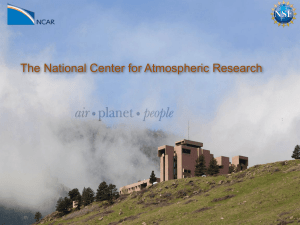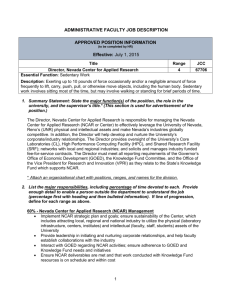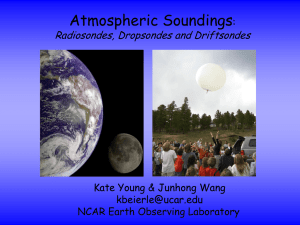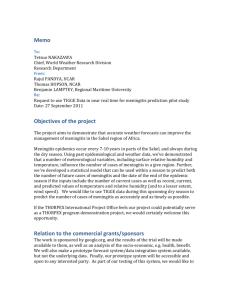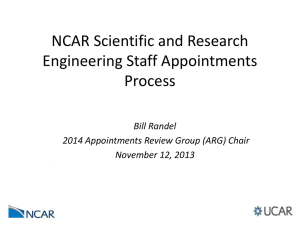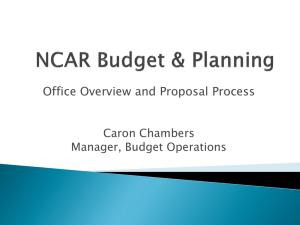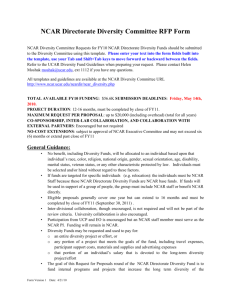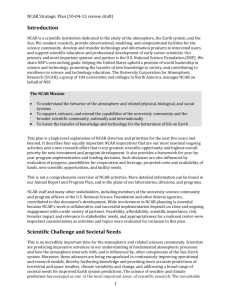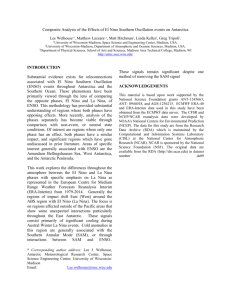February 24, 2014 - National Center for Atmospheric Research
advertisement
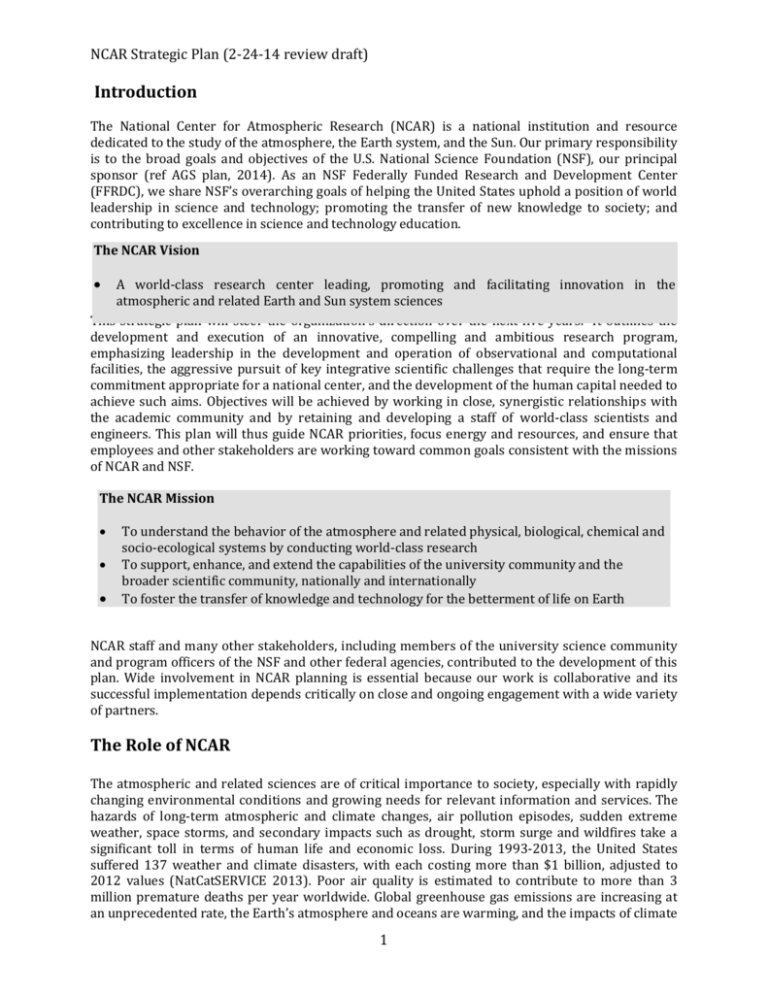
NCAR Strategic Plan (2-24-14 review draft) Introduction The National Center for Atmospheric Research (NCAR) is a national institution and resource dedicated to the study of the atmosphere, the Earth system, and the Sun. Our primary responsibility is to the broad goals and objectives of the U.S. National Science Foundation (NSF), our principal sponsor (ref AGS plan, 2014). As an NSF Federally Funded Research and Development Center (FFRDC), we share NSF’s overarching goals of helping the United States uphold a position of world leadership in science and technology; promoting the transfer of new knowledge to society; and contributing to excellence in science and technology education. The NCAR Vision A world-class research center leading, promoting and facilitating innovation in the atmospheric and related Earth and Sun system sciences This strategic plan will steer the organization's direction over the next five years. It outlines the development and execution of an innovative, compelling and ambitious research program, emphasizing leadership in the development and operation of observational and computational facilities, the aggressive pursuit of key integrative scientific challenges that require the long-term commitment appropriate for a national center, and the development of the human capital needed to achieve such aims. Objectives will be achieved by working in close, synergistic relationships with the academic community and by retaining and developing a staff of world-class scientists and engineers. This plan will thus guide NCAR priorities, focus energy and resources, and ensure that employees and other stakeholders are working toward common goals consistent with the missions of NCAR and NSF. The NCAR Mission To understand the behavior of the atmosphere and related physical, biological, chemical and socio-ecological systems by conducting world-class research To support, enhance, and extend the capabilities of the university community and the broader scientific community, nationally and internationally To foster the transfer of knowledge and technology for the betterment of life on Earth NCAR staff and many other stakeholders, including members of the university science community and program officers of the NSF and other federal agencies, contributed to the development of this plan. Wide involvement in NCAR planning is essential because our work is collaborative and its successful implementation depends critically on close and ongoing engagement with a wide variety of partners. The Role of NCAR The atmospheric and related sciences are of critical importance to society, especially with rapidly changing environmental conditions and growing needs for relevant information and services. The hazards of long-term atmospheric and climate changes, air pollution episodes, sudden extreme weather, space storms, and secondary impacts such as drought, storm surge and wildfires take a significant toll in terms of human life and economic loss. During 1993-2013, the United States suffered 137 weather and climate disasters, with each costing more than $1 billion, adjusted to 2012 values (NatCatSERVICE 2013). Poor air quality is estimated to contribute to more than 3 million premature deaths per year worldwide. Global greenhouse gas emissions are increasing at an unprecedented rate, the Earth’s atmosphere and oceans are warming, and the impacts of climate 1 NCAR Strategic Plan (2-24-14 review draft) change on communities and ecosystems are becoming more extensive. Ice melt in the Arctic and Greenland is outpacing the forecasts of today’s best models, and forecasts of the probabilities of changes in temperature, precipitation, and water availability are not yet at the fine spatial scale for effective use in regional adaptation and mitigation planning. Skill in predicting space-weather is currently not yet adequate for safeguarding radio communications, satellite-based navigation systems, and the electrical power grid. Many important aspects of the interactions of societal change and environmental change remain poorly characterized. Continued advancement in the atmospheric and related sciences, improvement in predictive capabilities, and more effective application of these advances to societal needs is more important than ever. NCAR has an exceptional record of leadership, scientific achievement and effective translation of scientific advances into useful knowledge for society. Weather, space weather, air quality, and climate change research are historical strengths of NCAR, and must remain so over the next five years and beyond. NCAR plays an important role in bringing relevant and objective information to national and international decisions on mitigation, adaptation, resiliency and sustainability. NCAR must also embrace a leadership role and actively engage with community leaders, research agencies, professional organizations, policy makers and others to convey significant research findings and emphasize the importance of investment in research and major facility development. NCAR is recognized for its unique and innovative approaches to collaborative science and service to the broader scientific community, such as the development of freely available community models and associated support services. NCAR also possesses the broad range and depth of scientific expertise and world-class observational science and computational facilities required to mount an end-to-end attack on some of today’s most significant environmental problems and interrelated sustainability and resilience issues. NCAR prides itself on sustaining research and facilities for the long haul, which is required to tackle difficult and important research challenges and develop solutions and highly valued services to the NSF community. Through its close ties to the university community and the role it plays as a crossroads for the exchange of ideas, NCAR will continue to think big, bring the best minds to the table for large-scale, sustained and highly collaborative research efforts, and emphasize active engagement with the stakeholders and consumers of its science. The Path Forward With exceptional assets in observational, computing and community model facilities, NCAR and its university partners are in an exceptional position to address the most-pressing problems in SunEarth system science. This strategic plan focuses on two grand challenges: improved understanding, prediction and projection of (1) atmospheric, chemical and space weather hazards and their impacts on ecosystems, people, and society; and (2) the diverse and potentially disruptive consequences of natural and anthropogenic climate change on regional scales. The latter includes the impacts of climate change on the water cycle, water availability, weather extremes, the health and functioning of marine and terrestrial ecosystems, the potential for abrupt changes in climate, and understanding the limits and options society has to respond to, and feedback on, climate change. These challenges are not new, but they are being continually reshaped by the broadening realization of their significant impact on society. At the heart of these challenges is our ability to observe and understand the complex Earth system, including forcings from the Sun and human systems. This knowledge must be encapsulated in dynamical models that provide increasingly skillful capabilities for predictions of changes in weather, climate, atmospheric chemistry, space weather, and associated impacts on socio- 2 NCAR Strategic Plan (2-24-14 review draft) ecological systems. A tension exists, however, between different directions for progress in modeling. Specifically, should resources be allocated and research efforts be extended to increase model resolution, ensemble size, or model complexity? The answer to this question should be problem-driven. Improvements in predicting high-impact weather events, such as severe storms and tropical cyclones, require significant increases in model resolution to capture important convective-scale forcing, and ensemble forecasting techniques are important to account for initial condition and model uncertainty. On the other hand, climate applications with great societal relevance, such as climate change impacts on water resources and sea-level rise, will require further advances in representing the complex interactions of the earth system (e.g., ice-sheet dynamics and land-surface hydrology). Significant progress will be achieved through the advancement of the Weather Research and Forecasting (WRF) Model and the Community Earth System Model (CESM), the continued development and community support of which will remain a research and service priority for NCAR. Historically, regional weather prediction models and global climate models have evolved on separate paths of development. However, with increasing computing power and advancing modeling technology, weather models are moving toward global coverage, while enhanced resolution climate models are beginning to resolve mesoscale processes. This trend toward multiscale simulation capabilities emphasizes that the traditional distinctions between “weather” and “climate” models are becoming increasingly blurred, and there is great synergistic benefit in developing unified modeling approaches for both physical processes and model dynamics. For weather prediction, there is the opportunity to benefit from the advances in climate modeling that reduce systematic errors due to mean-state drift, leading to more accurate medium-range weather and air quality forecasts. In turn, global climate and chemistry modeling can benefit from the experience of weather modelers in designing parameterizations for model physics that more accurately capture mesoscale weather systems, which will enhance understanding of the multiscale interactions in the coupled system. A major focus for NCAR over the next decade will be the pursuit of a more unified modeling strategy to support global models that run efficiently and accurately at a variety of horizontal resolutions, as well as developing global models with limited-area, higher-resolution grids for both regional downscaling and upscaling of information from local events. Both the global CESM and the Model for Prediction Across Scales (MPAS) are moving in this direction, and their utilization of variablemesh grids offers an improvement over current methodologies in regional modeling that employ boundary forcing from lower-resolution global models. These next-generation communitysupported modeling systems will also necessitate the development of “scalable” physical parameterizations and numerical algorithms (NRC 2012), as well as new techniques for modeling and coupling socio-ecological systems, human activities and decision-making with the biophysical components of the Earth system. They will form the basis for prediction systems that produce representative probabilistic forecasts from minutes to decades and provide societally relevant information across multiple spatial scales. Additionally, the development of predictive systems that more effectively address societal needs will necessarily involve decision makers and other users of predictive information in the definition and design of simulation experiments and related research projects. A strategic focus on the development and application of multi-scale simulation and prediction systems will also provide important opportunities for much stronger collaboration between the weather and climate modeling communities, both within NCAR and with the broader community. A particular strength of NCAR is that cutting-edge observational and modeling facilities reside sideby-side, with routine interaction between scientists and engineers pursuing research challenges from both perspectives. Observations are essential in order to evaluate models and attain the requisite process understanding to develop improved models. The development and deployment of 3 NCAR Strategic Plan (2-24-14 review draft) new observing systems, and the effective utilization of existing data from completed field campaigns, will thus be a critical component of a more unified modeling strategy, including observing systems targeted at important under-sampled phenomena, such as hurricanes and other severe storms over ocean areas. New observations are also needed to better understand and predict solar storms, and to increase scientific knowledge about complex, poorly understood interactions between biophysical and human systems, as well as social and behavioral processes of human system at multiple scales. A closer integration of data assimilation techniques and statistics with model development and verification is needed not only to generate initial conditions, but also to facilitate analysis of sensitivity and uncertainty, and assess the incremental benefit of new observations. New multi-scale simulation systems will push the modeling scale and complexity beyond the limits of current software engineering, data analytics and computer science capabilities. Achieving good performance, scalability, and fault tolerance on trans-petascale to exascale (1018 floating point operations per second) computers will necessitate new algorithms and revision of existing model designs. The next-generation computers will also require the development of radically new approaches to testing and optimizing software and new model validation strategies. The resultant large increase in model output will require new approaches for data storage and analysis. Developing new capabilities for extracting useful information from “Big Data” – large, diverse, distributed and heterogeneous data sets – will be integral to the path forward. Datasets that are impractical to deal with because they are either too large or too complex are a growing problem for the atmospheric and Sun-Earth science community, as they are rapidly outstripping the capabilities of current analysis tools and workflow practices and threaten to become a significant barrier to scientific progress in our fields. Bringing together large numbers of disparate observational and model datasets, and enhancing data publication and discovery by promoting data publication as a first-class scientific activity, will be critical to the development, validation and application of the next-generation multi-scale simulation systems. Addressing this challenge will require close collaboration with external agencies and data archives to standardize metadata and promote transparent data discovery, access, analysis, legacy, preservation and stewardship. NCAR will thus work toward an integrated, next-generation portfolio of “Big Data” services that exploit a shared security infrastructure. This data delivery environment will need to be developed in collaboration with those created by our research peers to ensure that our services can be externally federated and provide our research community with even greater assets. NCAR Imperatives The path forward will be organized within the framework of six “imperatives” – those ongoing efforts and activities that are essential to our role as a national research center and that form the foundation for our attack on the grand challenges noted above. By their nature, the imperatives are roughly equal in importance. NCAR Imperatives 1. Conduct innovative fundamental research to advance the atmospheric and related sciences NCAR is deeply engaged in the identification of new scientific frontiers and the development, evaluation, and dissemination of new approaches, methods, and tools. These activities are important for accelerating scientific progress, and often lead to efficiencies within the research enterprise that optimize the impact of constrained resources. NCAR fosters a culture of experimentation and encourages cross-disciplinary discovery through sustained interaction of our 4 NCAR Strategic Plan (2-24-14 review draft) staff and scientists with the broader research community to explore emerging issues and relevant opportunities. Being engaged at the intersection of exciting scientific opportunities and important societal needs, we value and support regular interactions with a wide range of non-scientific audiences. We are facilitating connections between the scientific community and public and private sector decision-makers who benefit from new scientific insights by increasing the involvement of stakeholders in the definition of scientific problems and in the planning and evaluation of our scientific efforts. There are many unanswered scientific questions about the processes and interactions that determine weather, climate, atmospheric chemistry, space weather and their predictability. For example, projecting changes in weather and climate over the coming decades depends on understanding the components of the land-atmosphere-ocean-cryosphere-human system and their multi-scale interactions, particularly those that regulate the cycling of water and carbon. Similarly, quantifying the role of solar variability in space and Earth climate requires investigations that span the entire system from the Sun's interior to the Earth's surface, along with the feedbacks that occur within the Earth’s atmosphere-ionosphere-magnetosphere system. Connecting research on the atmospheric chemistry-climate processes to research on climate impacts on human health are other examples of complex problems being addressed. Progress on all of these fronts requires integrative approaches involving a mix of theory, observations and models, and an understanding of the coupling between human and natural systems. Our priorities are to: Create an environment that enables creative exploration across the scope of NCAR science, including discovery-oriented research into key components of the Sun-Earth-human system in order to understand fundamental processes and mechanisms Develop process-level understanding, including the nature of couplings and feedbacks among the different components of the Sun-Earth-human system, and integrate this knowledge to better predict the behavior of the coupled system Determine the inherent predictability limits and explicitly quantify the uncertainty of predictions of the Sun-Earth system for weather, climate, air-quality and space weather applications Pursue strong interdisciplinary projects that join, in essential ways, the core atmospheric disciplines with the ecological, hydrological, biogeochemical, health, and social science communities In these pursuits, NCAR must continue to overcome barriers between basic research, use-inspired research and the application of this research by the operational community and decision makers for the benefit of society at large. 2. Develop, maintain and deploy advanced observational facilities and services Observations are of fundamental importance for the study of the Sun-Earth system and, as such, are an important foundation for the atmospheric and related sciences. Providing world-class airborne, ground-based and space-based observational facilities and services to the atmospheric and space physics communities is one of NCAR’s central responsibilities. In close collaboration with NSF and scientists at universities and other research organizations, we define observational challenges and opportunities, develop new capabilities, and advance the observational science frontiers. 5 NCAR Strategic Plan (2-24-14 review draft) The Lower Atmospheric Observing Facilities (LAOF) support observational surface-to-stratosphere weather and climate research. NCAR’s observational facilities include two instrumented research aircraft (the C-130 heavy-lift turboprop aircraft, and the high-altitude and long-range GV jet), a large ground-based mobile S-band radar (SPOL-Ka), the airborne HIAPER Cloud Radar, lidars, insitu and remote sounding systems, a tower flux network, and many associated instruments. These platforms and instruments are used to provide key measurements for studying and parameterizing fundamental atmospheric processes, and for initialization and verification of large-scale weather and climate models. The Mauna Loa Solar Observatory (MLSO), located on the Big Island of Hawaii, supports study of the solar atmosphere. It includes a new state-of-the-art K-coronagraph, a full-disk multi-wavelength irradiance monitor, and the Coronal Multi-channel Polarimeter (CoMP) instrument which provides unique daily observations of coronal magnetism. Maintaining excellent observational facilities, services and support depends on maintaining both strong observational science efforts at NCAR and robust links to the broader observational science community. This results in two positive impacts: (a) ensuring that NCAR’s facilities are state-of-the art and thus address current and future observational needs; and (b) providing opportunities for collaboration in areas such as instrument development, calibration and inter-comparison, data management, field organization and deployment, analysis of observations, model improvements and validation. Our priorities are to: Ensure the NSF-supported science community has access to world-class instruments by refining, maintaining, and operating existing facilities, conducting NSF-approved campaigns, developing new instruments and algorithms, and performing critical process research in support of observational and modeling science Advance community efforts and partnerships to build major next-generation facilities to enable significant advances in observations of atmospheric, chemical and space weather hazards, including the Airborne Phased Array Radar (APAR, on the C-130), the Coronal Solar Magnetic Observatory (COSMO), and the Atmospheric Chemistry Center for Observational Research and Data (ACCORD) Further develop methodologies to acquire, improve, restructure and manage observational datasets, evaluate their strengths and weaknesses for use in diagnostic studies and model evaluations, and distribute them in a timely and long-term sustainable manner to the broader research community NCAR will continue to collaborate with our sponsors and the broader scientific community to meet emerging observational research needs by operating the extant suite of NCAR observational facilities and contributing to the development of new ground-, airborne- and space-based community observing systems. NCAR remains committed to occasional targeted rapid response LAOF deployments for high impact events that supplement large coordinated field campaigns. New collaborative development efforts may include observing systems that facilitate the exploration of under-sampled atmospheric regions, networks of small inexpensive sensors to enable comprehensive global measurements of atmospheric constituents, a global ground-based network of solar telescopes to provide continuous space-weather diagnostics in near real-time, and an airborne instrument suite to study turbulent mixing, surface fluxes, and cloud processes to facilitate new insight into severe weather systems. 3. Develop, deliver and support a suite of advanced community models. One of NCAR’s outstanding accomplishments over the last several decades is the collaborative development and advancement of a series of community models. These models – which include the 6 NCAR Strategic Plan (2-24-14 review draft) Community Climate System Model (CCSM), the Weather Research and Forecast model (WRF), the Whole Atmosphere Community Climate Model (WACCM), and, more recently, the Community Earth System Model (CESM) and the Model for Prediction Across Scales (MPAS) – are the products of sustained cooperation between scientists from universities, other national laboratories and research organizations, and NCAR scientists, software engineers, and technical staff. The models cover the broad range of NCAR science including climate, weather, atmospheric chemistry, and space weather, and are widely used in both research and operations. Excellent software engineering practices are particularly critical for community models because their effectiveness depends on innovative, extensible and maintainable software that enables effective collaboration and can take advantage of new computational capabilities and algorithms. Our efforts build upon core theoretical and observational research and include the development of new techniques for initializing, constraining and validating models using a wide range of observational data sources. The model software and simulations are openly available to all interested parties free of charge. Stewardship of community models remains one of the most important services provided by NCAR to university researchers and other interested users. Our priorities are to: Accelerate advances in community models by incorporating improvements from community research results and by enhancing capabilities to couple models of components of the Sun-Earth system Develop and provide new multi-scale community modeling systems for weather-climate predictions and projections, spanning time scales from minutes to decades, with companion measures of uncertainty Adapt community models to emerging trans-petascale supercomputing architectures, and apply them to a wide range of pressing problems in Earth-Sun system science Continue a structured process for community involvement and expand community access to NCAR models through open source software along with the infrastructure that supports effective utilization of the models and their results, develop and provide advanced community tools for model testing and evaluation, including approaches and methods reflecting end-user purposes, and conduct modeling tutorials and workshops to entrain the next generation of scientists into their development and application The move toward a more unified approach to atmospheric and Earth system modeling is already underway, with the integration of chemical, upper atmosphere, climate, and weather modeling, and new high performance atmospheric dynamical cores that allow regional enhancement of resolution and better representations of motions at the meso- and cloud-scales. Current models that simulate the solar drivers of space weather and climate will be evaluated for developing Sun-Earth community models. Physical parameterizations that function across a range of scales and resolutions are fundamental to further progress. 4. Develop and sustain advanced information and computing system services High Performance Computing (HPC) is the foundation of much of NCAR’s scientific research and applications. NCAR is a critically important provider of supercomputing systems and services for the atmospheric and related sciences community and a key element of the research computation infrastructure of the United States. The recently completed NCAR-Wyoming Supercomputing Center (NWSC) is one of the world’s most advanced and efficient HPC facilities. NCAR maintains one of the largest repositories of atmospheric and Earth science data, containing information from both observations and model simulations. It is important, however, to recognize that supercomputing is not our only critical cyberinfrastructure: NCAR also provides high performance networking 7 NCAR Strategic Plan (2-24-14 review draft) infrastructure, and computing infrastructure for acquisition, quality control, and distribution of real-time data from field campaigns and observational sites. Our priorities are to: Sustain and enhance the supercomputing services provided to the atmospheric and related science community by preparing for the next upgrade of NWSC computing and data systems into the trans-petascale regime to enable increasingly data-centric science Develop, maintain, and operate discipline-specific data services, gateways, portals, products, and data analysis, visualization, and assimilation tools, including robust and portable cyberinfrastructure to support field campaigns, and provide near-real-time analysis Provide sufficient network bandwidth locally, regionally, nationally, and internationally in support of NCAR’s mission to advance science, technology, and education, and maintain operational reliability, integrity, scalability and adaptability of NCAR's networking functionality Looking ahead, NCAR will prepare for the exascale computing regime through continued testing and evaluation of – and adaptation to – rapidly evolving technologies in order to take advantage of new opportunities and minimize disruption of scientific productivity. 5. Develop and transfer science to meet societal needs. In addition to serving as the nation’s premier agency for promoting fundamental scientific research, NSF also intends its programs “to foster and encourage the translation of new knowledge generated through basic research into processes, products, and methodologies with significant economic or societal impact.” NCAR is a leader in collaborative research, development and technology transfer, expanding the reach of our science to address important problems that impact society. We consider active engagement with stakeholders who can benefit from our work to be a fundamental responsibility. The potential scope of our contribution is broad – from basic information about anthropogenic climate change to supporting such areas as renewable energy, water resources, transportation, agriculture, human health, urban planning and space operations. Much of this work is collaborative with universities, the University Corporation for Atmospheric Research (UCAR) Community Programs, other research organizations and the private sector. Our priorities are to: Develop and implement advanced methods and techniques to observe, analyze and predict weather, air quality, climate and the hydrologic cycle in support of decision making at local, regional and national levels, including provision of the requisite scientific information, datasets, analysis tools, training materials and capacity building Transfer to the community state-of-the-art numerical models, data assimilation procedures, numerical and diagnostic techniques, and user-centric verification methods for atmospheric, climate, hydrological and space weather forecasts Integrate information from the physical and social sciences on the impacts, risks and vulnerabilities associated with climate variability and change, terrestrial physical and chemical weather, and space weather to improve the communication of risk and uncertainty to a diverse population Societal vulnerability to extreme weather and climate change is expected to increase. There is thus a growing need for more precise and timely environmental information and better access to that information. We will respond to this challenge through advances in integrating physical and social sciences to generate and deliver new knowledge and information on critical impacts of weather and climate, including uncertainty estimates. We foresee expanded opportunities for stakeholder 8 NCAR Strategic Plan (2-24-14 review draft) engagement and extended collaborations with existing and new partners across multiple sectors to ensure that our activities are relevant and usable. 6. Educate and entrain a talented and diverse group of students and early career professionals We recognize that the health of our center is closely linked with the health of the atmospheric and related sciences community as a whole. The strength and success of NCAR and our entire community depends on the skills of those involved. A steady flow of new talent with new ideas and competencies is essential for scientific progress, not only at NCAR but also throughout our community. NCAR regards leadership in attracting, motivating and training the next generation of scientists and engineers as one of our fundamental responsibilities. We are committed to fostering graduate and postgraduate research and education, and to providing opportunities for undergraduate participation in NCAR research and promoting students' interest in our field. We offer a variety of early career employment opportunities that provide entry points and multiple pathways to different aspects of atmospheric and related research within our center and in the broader community. As a national center active in research, modeling and observational activities we provide unique hands-on educational experiences and opportunities for students, advisors and early career scientists to collaborate with a wide variety of scientists and engineers. NCAR also supports formal and informal education programs to showcase exciting developments and opportunities in science. We support ongoing education and flexible working conditions for our staff. We maintain strong visitor programs that enable early career scientists and engineers to spend time at NCAR and encourage NCAR scientists and engineers to visit universities and other institutions. Our priorities are to: Work with UCAR member universities and other academic institutions to identify opportunities for increasing the educational benefits of NCAR science Increase opportunities for NCAR researchers to engage in teaching, student research training and other educational activities in response to university requests, to collaborate with graduate students and their university advisors, and to maintain strong engagement with UCAR educational programs Continue and enhance our programs to involve students from traditionally underrepresented groups in all aspects of NCAR’s science and engineering, and aggressively pursue a diverse range of candidates for all visitor programs and employment opportunities Sustain a strong Advanced Study Program (ASP) Postdoctoral Fellowship program and other postdoctoral opportunities As technology makes remote teaching and collaboration more productive, NCAR will adopt methods to enable a virtual presence in university classrooms and give students improved interactive access to field campaigns and to NCAR observational facilities. We will increase our visibility in the rapidly evolving “digital commons” to share our knowledge and passion for the atmospheric and geospace sciences and establish an earlier and deeper relationship with students. As science evolves, new societal needs and challenges will be identified, and the problems addressed by NCAR and our community will change. Our workforce will also need to change and evolve. We will thus be proactive in supporting innovative science education and sustaining a wide range of opportunities for continuing education and flexible career development. 9 NCAR Strategic Plan (2-24-14 review draft) About NCAR (back cover box if published, appendix if virtual) NCAR’s research activities include the study of the atmosphere, the Earth system, the Sun and solarterrestrial physics, and the coupling of the atmosphere with oceans, biosphere, cryosphere and human activities. The Center consists of a directorate, five laboratories, and one crosscutting program (see org chart below). Our technical staff includes experts in meteorology, climate, atmospheric chemistry, mathematics, statistics, turbulence, hydrology, ecology, social sciences, health science, computer science, and software, mechanical, electrical and optical engineering. NCAR’s primary sponsor is the U.S. National Science Foundation. We also receive important support from other U.S. government agencies and international and private sector sponsors. We are a crossroads for scientific collaboration and the interaction of science and society. More than 6,593 participants attended over 123 workshops and colloquia at NCAR during 2012. We work closely with universities, environmental research and assessment programs, and other national and international research institutions to define scientific grand challenges and carry out sustained, long-term research projects. We interact regularly with decision makers in nongovernmental organizations, business, and local, national, and international government agencies to ensure that our research plans are informed by societal needs. We include our partners in decision making and direction setting for our institution. NCAR has a special relationship with the U.S. university community. NCAR was created more than 50 years ago to provide advanced facilities and research capabilities beyond the scale of individual university departments. Provision of services and facilities to university scientists, support for university education, and collaboration with university researchers remain central to our mission today. During 2012, academic and NCAR scientists coauthored 471 peer-reviewed papers, and NCAR worked with 109 different universities to submit 215 collaborative proposals to agencies other than NSF. One hundred and four North American universities and colleges provide governance of NCAR through their membership in the nonprofit UCAR, which manages our center on behalf of NSF. The UCAR Board of Trustees, elected by members, provides fiduciary, legal, and program oversight for NCAR and all other UCAR programs. In addition, 97 university representatives are currently serving on advisory panels for NCAR and its laboratories, divisions, and programs. 10
